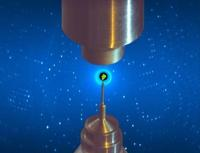Speaker
Description
Dancing water molecules on the surface of soluble proteins provide the essential lubricant for macromolecular function. Surprisingly, polymers attached to protein surfaces have been reported to replace hydration water and bring inactive dry proteins back to life (Perriman et al. (2010) Nat Chem 2, 622; Gallat et al. (2012) JACS 134, 13168). The mechanism behind polymer-assisted protein motions has remained elusive, however.
We have now combined elastic and quasi-elastic neutron scattering on TOFTOF and SPHERES (MLZ, Garching) and molecular dynamics simulations to shed light on the motions animating proteins and polymers in a water-free myoglobin – polymer hybrid (Schirò et al. (2021) Phys Rev Lett 126, 088102). Separating them was possibly by selectively masking the signal from either the polymer or the protein, using specific deuteration. Surprisingly, the polymer exhibits diffusion like motions that appear to substitute for hydration-water translational motions. Even if this substitution keeps dry proteins biologically active, certain dynamical modes are suppressed in the protein, possibly explaining the generally observed decrease in activity when hydration water is substituted by polymer coating. The study suggests ways to fine-tune polymer properties so that the decrease of protein activity can be minimized. This will be particularly important to rationally design protein-polymer hybrids for specific biotechnological applications, such as in medicine and cosmetics.

